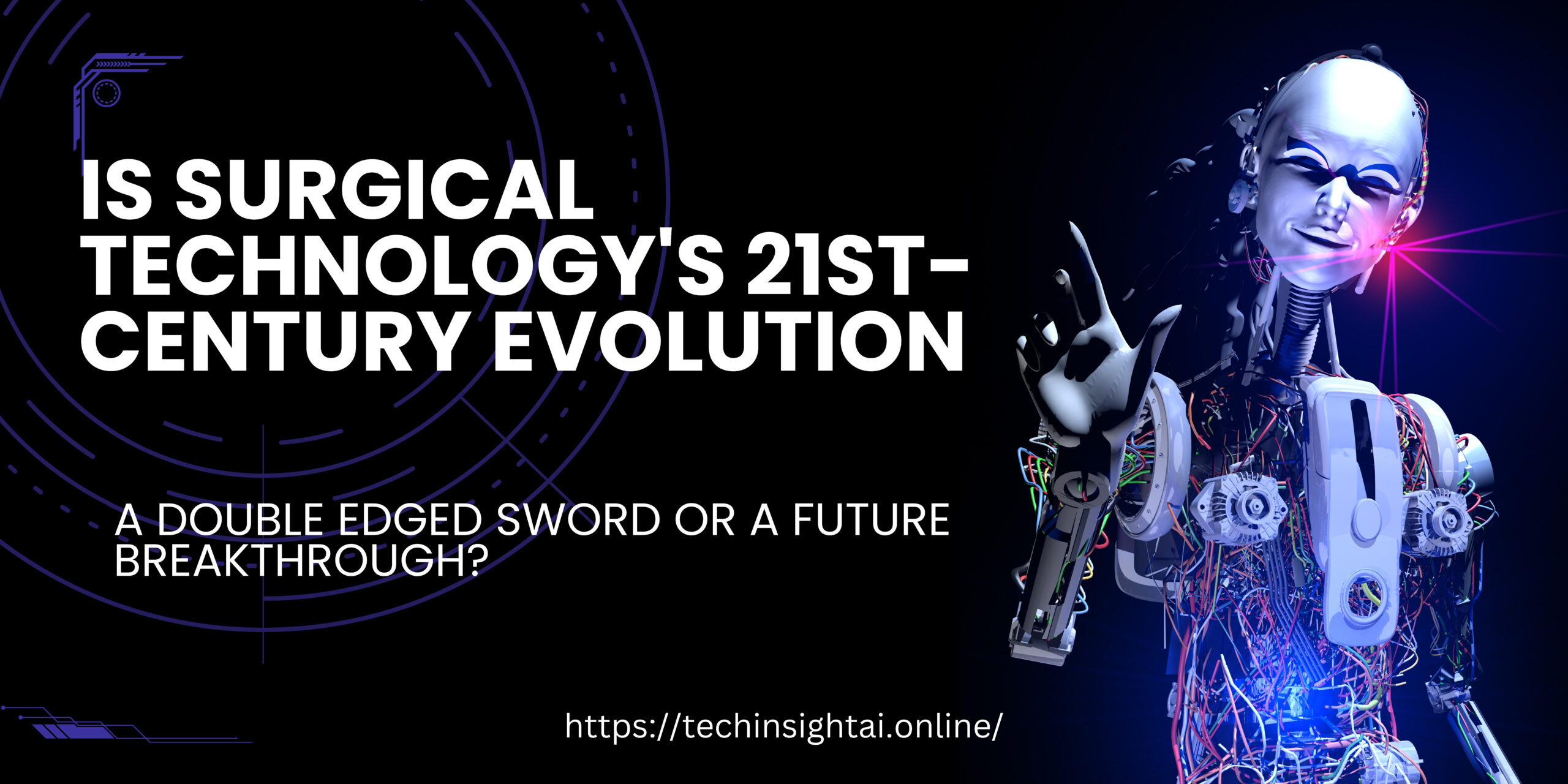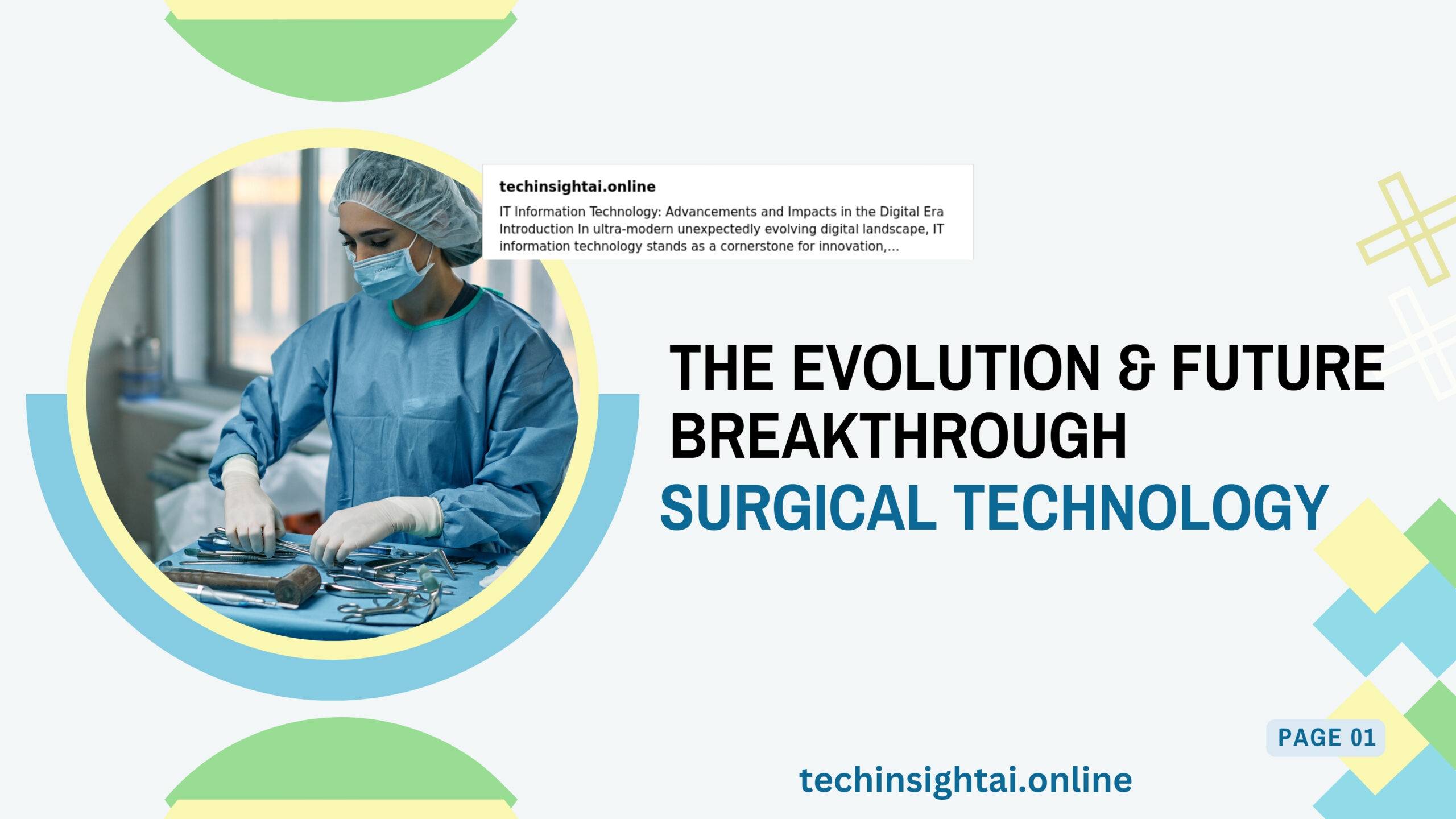The Evolution and Future of Surgical Technology
Introduction to Surgical Technology
The field of surgical technology has rapidly advanced over the past few decades, Transmor disagreement of surgical practices and benefits of patients.
![]()
![]()

The ideas of robotics, advanced tools, and even digital platforms have not only improved the fineness and safety of applying surgical operations but has also introduced new features to the least invasive surgical operations as well as individualized medicine. This article looks at the recent advancement in surgical technology, the effect that advancement seems to be having on the medical practice and what the future has in store.
The Historical Perspective: From Basic Tools to Advanced Surgical Technology
Surgical advancement has experienced a lot of changes from the old days when the surgeon used blunt tools and no anesthesia. More advancement came in the nineteenth century with the advent of antiseptics and anesthesia and thus more extensive surgical procedures became possible. But it was the20 century that marked a revolution in surgical technology ownership and apparatus instruments, imaging technologies as well as robotic systems.
The development of the laparoscopic surgery as a technique in the late twentieth century was deemed a major advancement in the field of surgery. This procedure proved to be less invasive than the traditional open surgery thus shortening recovery time for patients, having minimal scarring and less complications. When technology was involved the capability of the surgeons also increased and people received very delicate operations with high precision.
The integration of Robotics in the Current Surgeon’s Tools and Equipment
One of the most important milestones of the surgical innovation is the robotic surgery. The Robotic Surgical Systems – da Vinci Technology is modern day’s technology of performing surgeries. These systems provide increased accuracy, flexibility and sensitivity; thus the surgeon can easily conduct complicated operations, causing least interference to the body.Robotic systems are particularly beneficial in delicate surgeries, such as cardiac, neurosurgery, and urology, where precision is paramount. The technology allows for smaller incisions, leading to quicker recovery times and reduced post-operative pain for patients. Moreover, robotic systems can be integrated with advanced imaging technologies, providing real-time feedback and enhancing the surgeon’s ability to navigate complex anatomical structures.
The application of robotic systems is most productive where issues of precision are sensitive including; cardiology, neurological surgery and urological surgery. It allows the possibility to introduce minute injuries that can result in effective recuperation time with the minimum of after surgical procedures. In addition to this the robotic systems can be fitted with imaging systems to give the surgeon real time feedback as well as to orient the surgeon in the complex structures of the anatomy.
Minimally Invasive Surgery: Surgical Advancements – In Its Prime
Laparoscopic surgery, which is one of the types of the MIS now is regarded as the standard of care in many procedures all because of that advancement in the technological aspect of surgery. Using instruments like laparoscopes and endoscopes and with the assistance of higher resolution camera it is feasible to operate through minimal incisions hence the tissue damage is reduced.
Subsequent developments of MIS technology are as follows: For example, single-incision laparoscopic surgery (SILS) and natural orifice transluminal endoscopic surgery (NOTES) are prolonging borders at the endoscopic least invasion surgery. These techniques come with high benefits such as the ability to avoid formation of scarring, reduction of pain and short recovery period, hence making the experience of the patient a lot better.
Artificial intelligence and Machine Learning in our operating theatres
It should be noted that AI and machine learning are slowly but steadily entering a significant place while used in surgical technology. In this context, it can be seen that with the use of Artificial Intelligence, the decision-makers of surgeons can help surgeons in a number of ways from before surgery to even during surgery. For instance, it may analyze a medical image and tell the surgeon about the size of a tumor, location of nerves tissue and blood vessels among others and even estimate approximate probability of post-surgical complications.
Another aspect, on which, robust of the robotic surgical systems can be enhanced, is the presence of machine learning algorithms, which in their turn can learn from the prior surgeries. These systems can recognize tro car anatomy in every particular patient and attempt to provide specialized surgical solutions that can improve the result. In addition, new real-time surgical assistants are being deployed powered with artificial intelligence so that the surgeon can have augmented reality (AR) shows of the critical structures and their tools.
Role of Sterile Processing in Emergence of Three-dimensional Printing in Surgical Technology
Surgical technology has been up close and personal with probably the biggest revolution ushered in by 3D printing. This technology enables development of patients-specific models, surgical templates as well as implants. In one study at a medical university in Hamburg, surgeons said that they could use 3D-printed models to plan and practice operations, as well as better understand the affected body part of the patient.
In addition, it is also realized that the process of 3D printing is being adopted to design and even customize implants and prosthetics to match the patient. It has also proven effective in customizing the implants and in also minimizing the chances of post-surgery complications, thus boosting the success rate of the surgery. With the development of the 3D printing technology the prospects of its usage in the sphere of surgical technology are vast and are expected to deliver even higher efficiency and individuality of the surgeries.
Telemedicine and Remote Surgery: Surgical Technology in the future
Telemedicine is becoming more and more popular with the development of COVID-19, and its effects on surgical technology can also be seen. Robotic or telesurgery is a relatively new concept where the transfers of surgical operations from one geographical location to another through the use of communication technologies is allowed.
Owners translates to telesurgery as an application that has the ability to bring the specialized surgical talents in remote or inaccessible locations. This information technology also enables two or more surgeons to consult as they operated from different premises without moving the patient from one hospital to another. Dependence on new networks such as 5G will help in the improvement of the feasibility and reliability of the remote surgery hence the increase in its use in the future.
Augmented Reality in Surgery & its integration in the Surgical Process
Another great innovation in operation technology is augmented reality (AR). AR augments surgical data onto the surgeon’s view to give him/her timely data and visual cues during the surgery. It can increase the surgeon’s accuracy in completing the operation while decreasing the errors and the general impact on the surgery.
For instance, using augmented reality, it is possible to point out the blood vessels, nerves and other important structures in the course of an operation which will deter the surgeon from damaging them. In some cases, it can also give feedback on the position and the orientation of instruments to make the navigation of procedures created easier to the surgeons. The use of this AR technology is yet to grow as it is integrated into surgical technology and will provide new tools to the surgeons which they can use to boost their efficiency.
Medical Imaging Progress and Their Relation Onto Surgical Technology
Characteristic Technology has always been essential in planning and even performed surgeries. Based on conventional medical imaging, modern modifications as high resolution MRI, CT, and intraoperative imaging added higher accuracy into the surgical interventions. These technologies offer the surgeon real-time pictures of the anatomical arrangement and unique disposition of the internal organs of the patient and this aids in the planning of the surgeries or operations to be undertaken.
The special imaging techniques such as intraoperative imaging in particular have become part and parcel of modern surgery. This technology enables the surgeon to be able to see the area of surgery during the process with the result that adjustments to the surgery process may be made on as real-time basis as possible. For instance, intraoperative MRI can be employed during operations that involve the brain to validate that all tumors are quite eliminated while the health of the surrounding tissue is also considered.
Precision Medicine and Its Application in surgical procedures
Personalized medicine is also playing a significant role in developing the surgical technology as well. With the help of the new possibilities given by genomics and molecular biology it became easier to analyze individual variation among the patients in order to use individual approach during operations. This means that one can have unique surgical strategies tailored on their genes and the used techniques and technologies will best suit that particular disease.
In addition, personalized medicine is pushing emergence of new surgical technologies that would address different characteristics each patient. For instance, surgical instruments and Implants are perhaps the best examples where using 3D printing technology will promise specific designs customized for the individual patient to avoid surgeries that may lead to complications. Codification of personalized medicine it has been found that integration of engineered surgery with personalized medicine would result in providing surgical care, which is; accurate, efficient, individual and patient orientated.
Professional, Ethical and Legal Issues in Surgical Technology
With the development of technological world especially in the field of surgery it has posed number of questions in ethical and legal background. Incorporation of AI, robotics and other innovative technologies in surgery introduces new concept of liability, patient’s consent and data protection. For instance, in cases where an AI Surgical System provides wrong results, then who is to blame? The various aspects of the patients’ data are well protected, and they can trust the data not to be used improperly.
All these questions are playing much importance in the current world due to the advancement of surgical procedures. While it is the human’s switch to utilize the advanced technologies in trending fields there is a dire need for the medical community, policymakers, and legal experts to adopt ethical policies to govern the use of such technologies. This will be important in sustaining public confidence especially with the developing trends in surgical procedures so that people can benefit from the technology without any prejudice to their rights and safety.

The Future of Surgical Technology: What Lies Ahead?
The future of the surgical equipment and technology is bright as a great of novelties is expected to be unveiled soon. Its envision that with the use of advanced technologies in robotics, artificial intelligence, augmented reality, and 3D printing the accuracy of health risk reduction, surgical safety, and efficacy will be improved. Further, the adoption of such technologies in association with the concept of PM will also mean that people are likely to receive specific and appropriate surgeries as treatment procedures.In the future, the results predict further development of such innovations as remote surgery and telemedicine, which will help to make top-tier surgical care available to patients across the global. Also, the increase in new material and techniques, which have emerged from tissue engineering and bioengineering could be a game changer in the practice of transplant surgery and medicine. That being the case, as these technologies advance in the future, the position of the surgical technologist will also undergo some shifts. Surgical technologists will have to acquire new skills and knowledge and learn new things in order to adapt to new technologies successfully. As a result it is expected that educational and training programs will have a key responsibility of preparing the future generation of surgical technologists for the future challenges and benefits that are expected to accost the profession in future.
Conclusion
Surgical technology or the use of advanced equipment in surgeries is a fascinating advancement in the field of surgeries, not to mention the possibilities that it presents to surgeons as well as patients. Starting from the incorporation of robotics and AI in the surgical procedures to the emergence of minimally invasive surgery and the development of the field of personalized medicine, the innovations in surgical technology are changing the faces of the surgical procedures. For the future, the further development of such technologies is expected to increase the skills of performing operations and the quality of patients’ treatment. Still, it will be important to continue the further development of these technologies and to face the ethical and legal issues connected with them in order to apply these technologies in a safe way and get all the potential advantages.


Pingback: How Will Health Information Technology's Dual Impact Shape the Future of Healthcare in 2024? - techinsightai.online